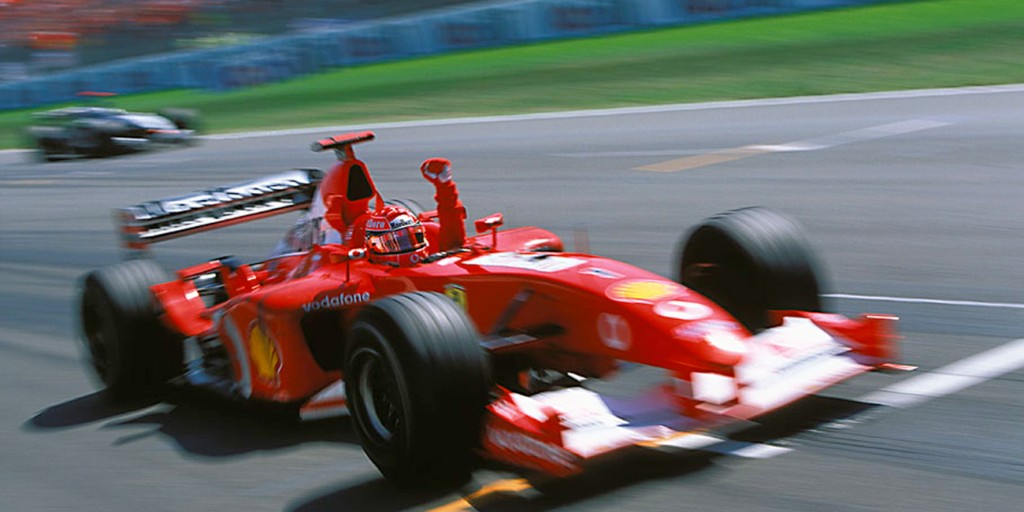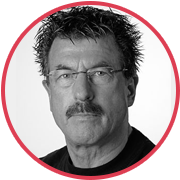
Rainer W. Schlegelmilch: “I am Generally Fond of Racing, But to be Shooting it is an Unrivalled Pleasure”
Rainer Schlegelmilch has been shooting Formula 1 for over 50 years. He remembers racing in “pre-Schumacher” time and knows it’s protagonists very well. Schlegelmilch’s black-and-white negatives tell the tale of Formula 1 characters: their ascent to fame, their moments of glory, their decline and, occasionally, their death. In an interview with Bird In Flight the photographer speaks about the ways car racing has changed, what it was like a few decades ago, what happens backstage, and what makes a really spectacular race.

I got my first camera when I was 14, and at 19 I began studying photography at the Art Academy of Munich. I opened a studio of commercial photography and started making money. Everything was perfect. I was successful and self-assured. But, at a certain point I got involved with the racing. And it changed my life.
50 years ago there were just ten classic world grand-prix Formula 1 championships. Six of them were in Europe. The photographers were mainly newspaper reporters, with small cameras of the Rollei kind or even the bulky 3×4 inch plate cameras. Very few had a 35mm camera like myself.
{ “img”: “/wp-content/uploads/2015/03/reiner01.jpg”, “text”:”1987, Austrian Grand Prix, Zeltweg. Italian pilot Andrea de Cesaris.” },
{ “img”: “/wp-content/uploads/2015/03/reiner02.jpg”, “text”:”2002, French Grand Prix, Magny Cours. German pilot Michael Schumacher.” },
{ “img”: “/wp-content/uploads/2015/03/reiner03.jpg”, “text”:”2002, Austrian Grand Prix, Österreichring. Michael Schumacher.” },
{ “img”: “/wp-content/uploads/2015/03/reiner04.jpg”, “text”:”2002, French Grand Prix, Magny Cours. Michael Schumacher.” },
{ “img”: “/wp-content/uploads/2015/03/reiner05.jpg”, “text”:”2003, Austrian Grand Prix, Spielberg. German pilot Michael Schumacher.” }
I remember my very first Formula 1 very clearly. It was Spa-Francorchamps, Belgium, in 1962. I took a lot of pictures there and still consider them among the best in my career. It was the first impression effect.
There is a very clear sequence of actions and moves of people involved with Formula 1, traditions that count a few decades of years. At first you go to the place where everything is going on: where the pilots, their teams, the wives and representatives of the committee come together. Then a qualifying session begins and everyone rushes to the pit stop where all the preparatory work is done. You look for the shooting position. The most favorable spots are in the curves and bends of the racing track. The moment when the racers come to the paddock (place used as a team garage – BiF.) is the best for portrait photography. Everyone is excited, people’s feelings are written across their faces, there’s a lot of gesturing, laughter, the atmosphere is charged with emotion.
In early 1990s F-1 started to change, and that was a considerable, visible change. Federation Internationale de L’Automobile (FIA) undertook an “inventory” of all the media that wrote about racing. Grand prix events henceforth could only be photographed by journalists with a FIA accreditation, they had to be staff photographers of a limited number of newspapers and magazines with no less than 270 published stories a year. As for me, I never worked for any media: I was making books, calendars. So they kicked me out.
Bernie Ecclestone, the irreplaceable F-1 manager and FOM president, on hearing that I had lost my accreditation, offered me to become his own photographer with a permanent FOM pass. Because I was always in sight and around and was taking my work very seriously. In that status I have been shooting F-1 for over 20 years.
{ “img”: “/wp-content/uploads/2015/03/reiner06.jpg”, “text”:”1970, Spanish Grand Prix, Jarama. New Zealand racer Bruce Mclaren drives past a crash involving Jack Oliver and Jacky Ickx. Bruce came second in that race.” },
{ “img”: “/wp-content/uploads/2015/03/reiner07.jpg”, “text”:”2014, Monaco Grand Prix, Mirabeau. Pre-qualifying race of Swedish F-1 driver Marcus Ericsson.” },
{ “img”: “/wp-content/uploads/2015/03/reiner08.jpg”, “text”:”1985, Monaco Grand Prix, Monte Carlo. Swedish racer Stefan Johansson.” },
{ “img”: “/wp-content/uploads/2015/03/reiner09.jpg”, “text”:”2014, Abu Dhabi Grand Prix, world champion, Lewis Hamilton from Great Britain.” },
{ “img”: “/wp-content/uploads/2015/03/reiner10.jpg”, “text”:”Grid girls at F-1.” },
{ “img”: “/wp-content/uploads/2015/03/reiner11.jpg”, “text”:”2004, European Grand Prix, Nürburgring. German racer Ralf Schumacher.” }
I am generally fond of racing, but to shoot it is a particular pleasure. I like looking through my photographs. In the years I have spent shooting motor racing those photographs have become the meaning of my life. Every grand prix was a personal story.
Pictures keep historical moments. They keep for us the people who have passed away and events that took place long ago and will never repeat. This is what I love photo art for — it is a hidden back door to the past. The best moment is easy to single out — it enlivens a moment in history. Sometimes if you are lucky you can take such a picture.
Death is the most horrible thing in my favorite sports. Even now I very clearly remember the death of Jim Clark, Piers Courage, Jochen Rindt, Jo Siffert, Gilles Villeneuve and of course, Ayrton Senna. They are the champions, they are the geniuses, it is impossible to forget them. Every name is a long story of glory. I have been lucky to observe their struggle and to see them on the summit of their fame. But I have always been too close, I have seen it all, all those dreadful crashes. And sometimes I hated the formula. It was killing its loved ones.
Until 2004 I was shooting racing with a film camera. Having to reload a film at a crucial moment was a nightmare! Nowadays lenses are bigger and heavier. Photographers need to work three times harder than in the 1960s. But new technology has dramatically changed the spectators’ perception of racing.
{ “img”: “/wp-content/uploads/2015/03/reiner12.jpg”, “text”:”1966, Dutch Grand Prix, Zandvoort. Scottish racing driver Jim Clark.” },
{ “img”: “/wp-content/uploads/2015/03/reiner13.jpg”, “text”:”1968, Dutch Grand Prix, Zandvoort. Scottish racer Jacky Stuart and his wife.” },
{ “img”: “/wp-content/uploads/2015/03/reiner14.jpg”, “text”:”1962, Grand Prix of Belgium, Spa-Francorchamps. Austrian motor racer Jack Brabham.” },
{ “img”: “/wp-content/uploads/2015/03/reiner15.jpg”, “text”:”1967, Grand Prix of Monaco, Monte Carlo. English racer Graham Hill and Swiss racer Jo Siffert.” },
{ “img”: “/wp-content/uploads/2015/03/reiner16.jpg”, “text”:”1966, European Grand Prix, Nürburgring. Jacky Stuart.” },
{ “img”: “/wp-content/uploads/2015/03/reiner17.jpg”, “text”:”1967, Dutch Grand Prix, Zandvoort. Race winner Jim Clark.” }
Grand Prix of Monaco is the most spectacular race in the world. Amazing landscapes, amazing atmosphere! Photographers there are closer to the cars, to the Formula pilots. Because on so many other racing tracks preoccupation with security regulations has resulted in the fact that photographers are no longer allowed to shoot from close distance. On so many stretches of the track where photographers for years took their best pictures, it is now impossible even to stand because of the safety regulations.
Young F-1 was dangerous, but that’s one of the reasons why it was so attractive. The risk worked like a magnet — both for the public and the pilots. In 1994 Senna became F-1’s last crashed racer. So now the spectators think they are lucky if they see a tiny accident. But of a kind, of course, where no one gets killed or injured.
Portraits are an important part of F-1 photography. But pilots nowadays are too young, and very few can boast of an interesting face, of a personality. In good old days racers were aged 30 to 50, and those were characters with life experience. They were charismatic, and their faces were very expressive.
{ “img”: “/wp-content/uploads/2015/03/reiner_01.jpg”, “text”:”2014, German Grand Prix, Hockenheim. German racer Nico Rosberg wins the race.” },
{ “img”: “/wp-content/uploads/2015/03/reiner_02.jpg”, “text”:”Venezuelan driver Pastor Maldonado.” },
{ “img”: “/wp-content/uploads/2015/03/reiner_03.jpg”, “text”:”2013, German racer Sebastian Vettel (left) becomes the world champion for the 3rd time and receives acknowledgements from Michael Schumacher.” },
{ “img”: “/wp-content/uploads/2015/03/reiner_04.jpg”, “text”:”McLaren team waiting for their racer at the pit stop.” },
{ “img”: “/wp-content/uploads/2015/03/reiner_05.jpg”, “text”:”2014, Brazilian racer Felipe Massa.” },
{ “img”: “/wp-content/uploads/2015/03/reiner_07.jpg”, “text”:”2014, Grand Prix of Monaco. Australian racer Daniel Riccardo.” },
{ “img”: “/wp-content/uploads/2015/03/reiner_08.jpg”, “text”:”2014. Nico Rosberg.” },
{ “img”: “/wp-content/uploads/2015/03/reiner_09.jpg”, “text”:”2014. Nico Rosberg’s pit stop.” },
{ “img”: “/wp-content/uploads/2015/03/reiner_10.jpg”, “text”:”2014, British racer Max Chilton at F-1 pilot parade.” }
Racing tracks nowadays are equipped with spacious lodges for administration, racers, their assistants and teams. The cars themselves, and spare parts for them, are stored in garages. Everything has become more hermetic, out of reach of the people. In the last six years I didn’t have a single opportunity to photograph an engine or a transmission box. And for a helmet-on portrait of a racing driver I need to fight with other photographers. We all used to be friends in the past, but nowadays everyone has his own VIP-zone and no one is anyone’s friend. After the Grand Prix of Monaco the Automobile Club and Prince Albert are genuinely happy if the winner of the race and his friends spend at least two hours at the after party. The world peace has been defeated by paranoia, obsession with safety and security.
I have photographed over 600 races. Luckily I have lifetime accreditation for any Grand Prix events, being a member FMO 500 Club that was founded to unite the most faithful of F-1 reporters and photographers. A lot has changed since then, but for me the race is going on, and I am still a long way from the finish line. Last year I photographed seven races and started exhibiting my black-and-white photographs from the 1960s. I have a lot of plans for 2015. More races, more books, Grand Prix of Monaco, Monza, but almost certainly not Sochi.
{ “img”: “/wp-content/uploads/2015/03/reiner18.jpg”, “text”:”1970, Austrian Grand Prix, Zeltweg. Austrian racer Jochen Rindt (centre), his wife and British automotive designer Colin Chapman. A few months prior to the racer’s death.” },
{ “img”: “/wp-content/uploads/2015/03/reiner19.jpg”, “text”:”1971, Spanish Grand Prix, Montjuïc Park. Grahan Hill.” },
{ “img”: “/wp-content/uploads/2015/03/reiner20.jpg”, “text”:”1991, U.S. Grand Prix, Phoenix. Brazilian racer Ayrton Senna, preparation for victory.” },
{ “img”: “/wp-content/uploads/2015/03/reiner21.jpg”, “text”:”1963, Dutch Grand Prix, Zandvoort.” }
New and best




